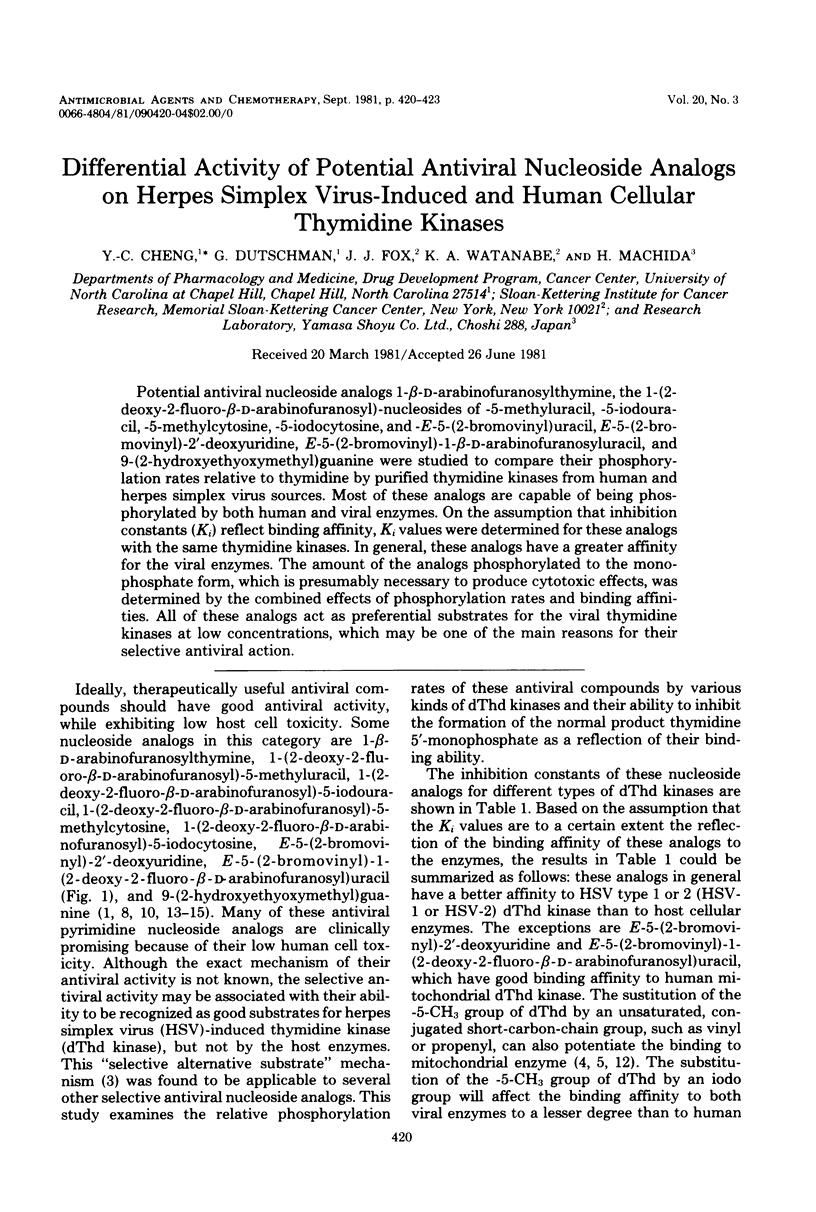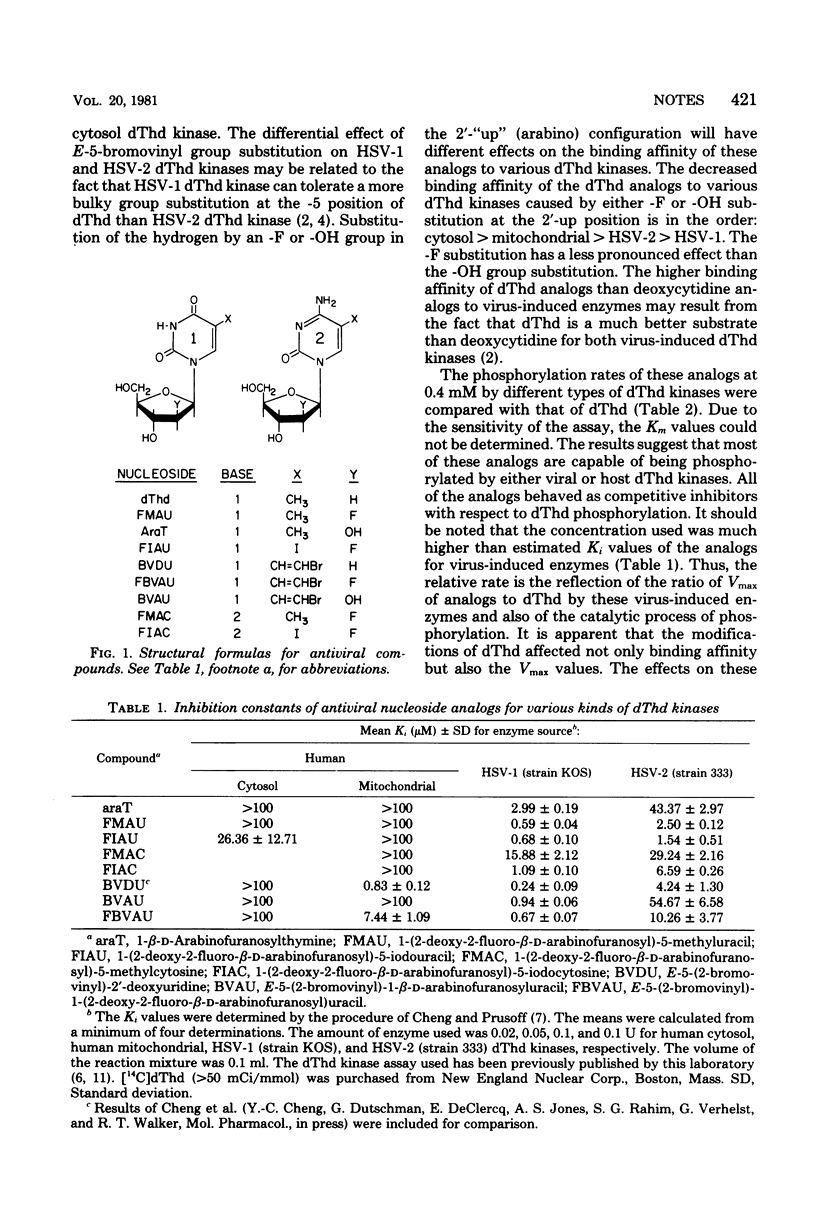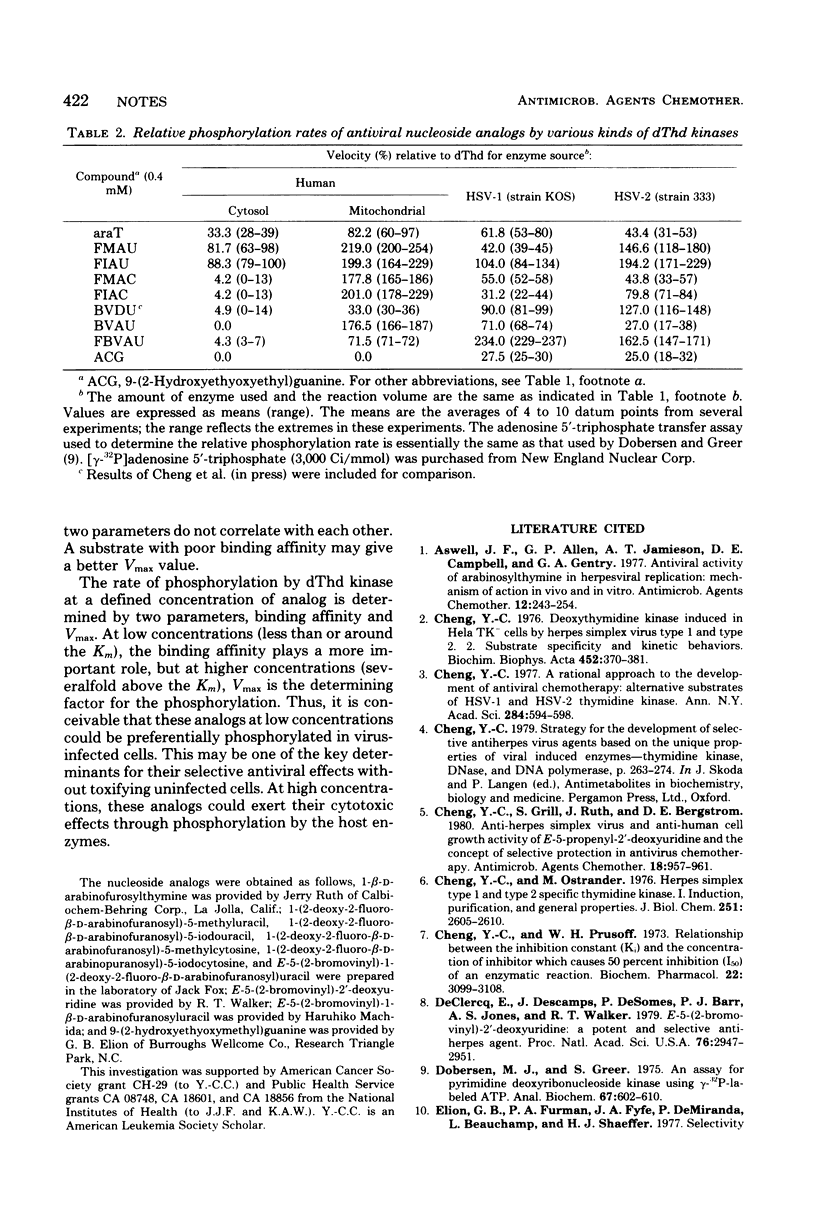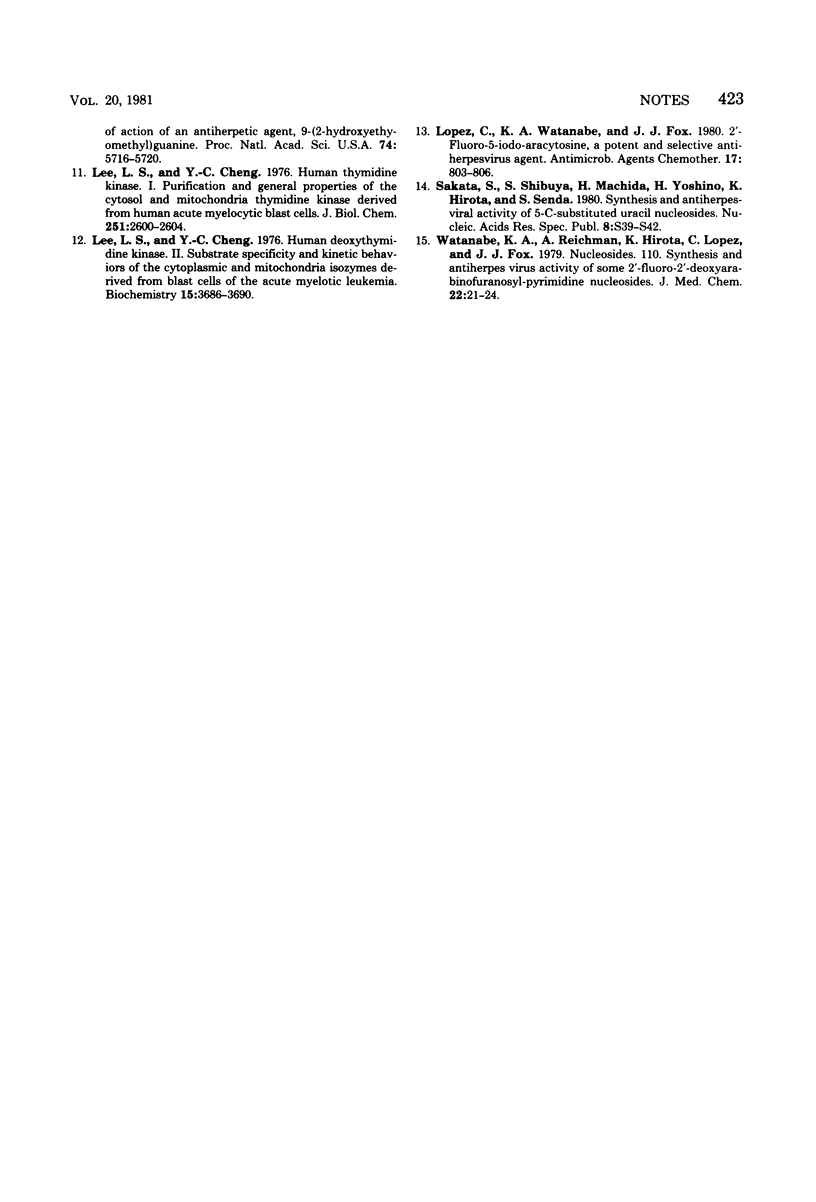Abstract
Potential antiviral nucleoside analogs 1-beta-D-arabinofuranosylthymine, the 1-(2-deoxy-2-fluoro-beta-D-arabinofuranosyl)-nucleosides of -5-methyluracil, -5-iodouracil, -5-methylcytosine, -5-iodocytosine, and -E-5-(2-bromovinyl)uracil, E-5-(2-bromovinyl)-2'-deoxyuridine, E-5-(2-bromovinyl)-1-beta-D-arabinofuranosyluracil, and 9-(2-hydroxyethyoxymethyl)guanine were studied to compare their phosphorylation rates relative to thymidine by purified thymidine kinases from human and herpes simplex virus sources. Most of these analogs are capable of being phosphorylated by both human and viral enzymes. On the assumption that inhibition constants (Ki) reflect binding affinity, Ki values were determined for these analogs with the same thymidine kinases. In general, these analogs have a greater affinity for the viral enzymes. The amount of the analogs phosphorylated to the monophosphate form, which is presumably necessary to produce cytotoxic effects, was determined by the combined effects of phosphorylation rates and binding affinities. All of these analogs act as preferential substrates for the viral thymidine kinases at low concentrations, which may be one of the main reasons for their selective antiviral action.
Full text
PDF



Selected References
These references are in PubMed. This may not be the complete list of references from this article.
- Aswell J. F., Allen G. P., Jamieson A. T., Campbell D. E., Gentry G. A. Antiviral activity of arabinosylthymine in herpesviral replication: mechanism of action in vivo and in vitro. Antimicrob Agents Chemother. 1977 Aug;12(2):243–254. doi: 10.1128/aac.12.2.243. [DOI] [PMC free article] [PubMed] [Google Scholar]
- Cheng Y. C. A rational approach to the development of antiviral chemotherapy: alternative substrates of herpes simplex virus Type 1 (HSV-1) and Type 2 (HSV-2) thymidine kinase (TK). Ann N Y Acad Sci. 1977 Mar 4;284:594–598. doi: 10.1111/j.1749-6632.1977.tb21992.x. [DOI] [PubMed] [Google Scholar]
- Cheng Y. C. Deoxythymidine kinase induced in the HELA TK- cells by herpes simplex virus type I and type II. Substrate specificity and kinetic behavior. Biochim Biophys Acta. 1976 Dec 8;452(2):370–381. doi: 10.1016/0005-2744(76)90186-8. [DOI] [PubMed] [Google Scholar]
- Cheng Y. C., Grill S., Ruth J., Bergstrom D. E. Anti-herpes simplex virus and anti-human cell growth activity of E-5-propenyl-2'-deoxyuridine and the concept of selective protection in antivirus chemotherapy. Antimicrob Agents Chemother. 1980 Dec;18(6):957–961. doi: 10.1128/aac.18.6.957. [DOI] [PMC free article] [PubMed] [Google Scholar]
- Cheng Y. C., Ostrander M. Deoxythymidine kinase induced in HeLa TK- cells by herpes simplex virus type I and type II. II. Purification and characterization. J Biol Chem. 1976 May 10;251(9):2605–2610. [PubMed] [Google Scholar]
- Cheng Y., Prusoff W. H. Relationship between the inhibition constant (K1) and the concentration of inhibitor which causes 50 per cent inhibition (I50) of an enzymatic reaction. Biochem Pharmacol. 1973 Dec 1;22(23):3099–3108. doi: 10.1016/0006-2952(73)90196-2. [DOI] [PubMed] [Google Scholar]
- De Clercq E., Descamps J., De Somer P., Barr P. J., Jones A. S., Walker R. T. (E)-5-(2-Bromovinyl)-2'-deoxyuridine: a potent and selective anti-herpes agent. Proc Natl Acad Sci U S A. 1979 Jun;76(6):2947–2951. doi: 10.1073/pnas.76.6.2947. [DOI] [PMC free article] [PubMed] [Google Scholar]
- Dobersen M. J., Greer S. An assay for pyrimidine deoxyribonucleoside kinase using gamma-32P-labeled ATP. Anal Biochem. 1975 Aug;67(2):602–610. doi: 10.1016/0003-2697(75)90335-8. [DOI] [PubMed] [Google Scholar]
- Lee L. S., Cheng Y. C. Human deoxythymidine kinase. I. Purification and general properties of the cytoplasmic and mitochondrial isozymes derived from blast cells of acute myelocytic leukemia. J Biol Chem. 1976 May 10;251(9):2600–2604. [PubMed] [Google Scholar]
- Lee L. S., Cheng Y. c. Human deoxythymidine kinase II: substrate specificity and kinetic behavior of the cytoplasmic and mitochondrial isozymes derived from blast cells of acute myelocytic leukemia. Biochemistry. 1976 Aug 24;15(17):3686–3690. doi: 10.1021/bi00662a007. [DOI] [PubMed] [Google Scholar]
- Lopez C., Watanabe K. A., Fox J. J. 2'-fluoro-5-iodo-aracytosine, a potent and selective anti-herpesvirus agent. Antimicrob Agents Chemother. 1980 May;17(5):803–806. doi: 10.1128/aac.17.5.803. [DOI] [PMC free article] [PubMed] [Google Scholar]
- Sakata S., Shibuya S., Machida H., Yoshino H., Hirota K., Senda S., Ikeda K., Mizuno Y. Synthesis and antiherpesviral activity of 5-C-substituted uracil nucleosides. Nucleic Acids Symp Ser. 1980;(8):s39–s42. [PubMed] [Google Scholar]
- Watanabe K. A., Reichman U., Hirota K., Lopez C., Fox J. J. Nucleosides. 110. Synthesis and antiherpes virus activity of some 2'-fluoro-2'-deoxyarabinofuranosylpyrimidine nucleosides. J Med Chem. 1979 Jan;22(1):21–24. doi: 10.1021/jm00187a005. [DOI] [PubMed] [Google Scholar]


